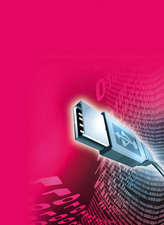Techniques for working with devices in Linux
Device Tricks

Linux is getting much better at managing devices, and the versatility of open source software leads to some interesting innovations.
Experts and beginners will tell you that devices are the perennial challenge of Linux systems. Linux is fast, stable, and safe – if you can get it to run on your hardware. We all have our war stories, but most users will affirm that the penguin's affinity for PC hardware is improving. Many of the device problems that plagued Linux systems in the early days were solved years ago. A Linux user from 1999 would be totally amazed to install a Linux system today and watch the system auto-locate the hardware. But maybe not all the hardware. Linux still has trouble with certain devices, and the lag time between the appearance of a new driver and its integration can mean a built-in driver isn't available for months.
This month's Device Tricks cover story starts with a study of some recent developments in driver management tools for Linux. Jon Masters describes some of the obstacles facing Linux developers and looks at some recent solutions that promise more seamless device support.
The next article in this month's set looks at a library of tools for supporting MTP-based devices such as music players and webcams in Linux. We'll describe some open source applications that support MTP, and you'll learn how to communicate with MTP devices from the command line. Next we examine the aufs2 stacked filesystem, which lets you add temporary write capability to a filesystem on a read-only device. The last article in the set shows how you can protect your privacy by encrypting the data on your USB sticks.
[...]
Buy this article as PDF
(incl. VAT)
Buy Linux Magazine
Subscribe to our Linux Newsletters
Find Linux and Open Source Jobs
Subscribe to our ADMIN Newsletters
Support Our Work
Linux Magazine content is made possible with support from readers like you. Please consider contributing when you’ve found an article to be beneficial.

News
-
Mozilla Plans to AI-ify Firefox
With a new CEO in control, Mozilla is doubling down on a strategy of trust, all the while leaning into AI.
-
Gnome Says No to AI-Generated Extensions
If you're a developer wanting to create a new Gnome extension, you'd best set aside that AI code generator, because the extension team will have none of that.
-
Parrot OS Switches to KDE Plasma Desktop
Yet another distro is making the move to the KDE Plasma desktop.
-
TUXEDO Announces Gemini 17
TUXEDO Computers has released the fourth generation of its Gemini laptop with plenty of updates.
-
Two New Distros Adopt Enlightenment
MX Moksha and AV Linux 25 join ranks with Bodhi Linux and embrace the Enlightenment desktop.
-
Solus Linux 4.8 Removes Python 2
Solus Linux 4.8 has been released with the latest Linux kernel, updated desktops, and a key removal.
-
Zorin OS 18 Hits over a Million Downloads
If you doubt Linux isn't gaining popularity, you only have to look at Zorin OS's download numbers.
-
TUXEDO Computers Scraps Snapdragon X1E-Based Laptop
Due to issues with a Snapdragon CPU, TUXEDO Computers has cancelled its plans to release a laptop based on this elite hardware.
-
Debian Unleashes Debian Libre Live
Debian Libre Live keeps your machine free of proprietary software.
-
Valve Announces Pending Release of Steam Machine
Shout it to the heavens: Steam Machine, powered by Linux, is set to arrive in 2026.

